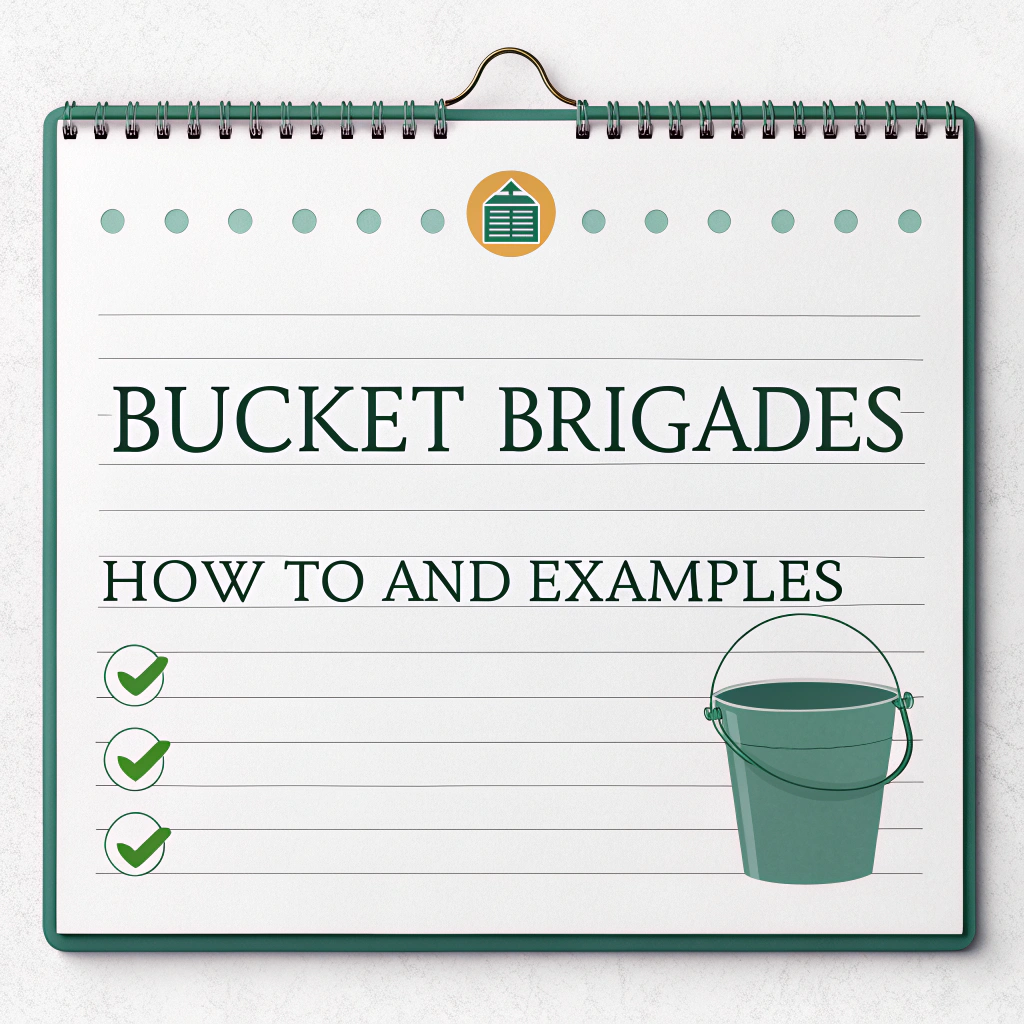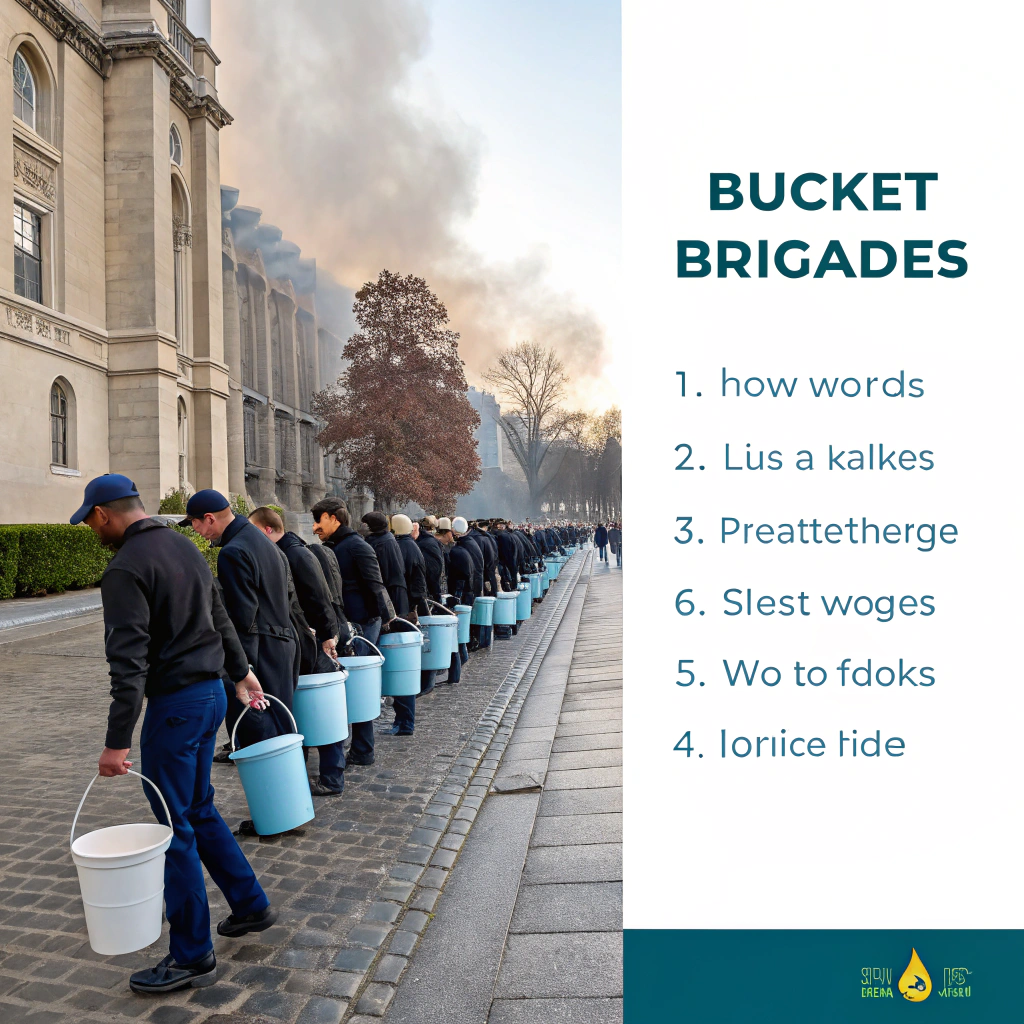
Bucket Brigades Words: How to and Examples (List)
“Learn the art of creating efficient Bucket Brigades with our comprehensive guide. From simple setups to advanced techniques, we’ve got you covered!”
Bucket brigades are a common method used to transport liquids or other materials from one location to another. They involve forming a line of people, each person holding a bucket or other container, with the first person filling their bucket at the source and the last person emptying their bucket at the destination. This method is often used in emergency situations, such as fires, to quickly move water to the firefighters. In this article, we will discuss how to form a bucket brigade and provide some examples of how it can be used.
How to Build a Bucket Brigade Circuit
Bucket brigades are an essential component in many industrial and manufacturing processes. They are used to transport materials from one location to another, often over long distances or in hazardous environments. In this article, we will discuss how to build a bucket brigade circuit and provide some examples of their use.
To build a bucket brigade circuit, you will need the following materials: a bucket, a rope or chain, and a weight. The weight can be anything heavy enough to move the bucket easily, such as a rock or a piece of metal. The circuit should be designed in a way that allows the weight to be attached to the bucket at one end and then moved along the rope or chain to the other end.
Once the circuit is complete, you can begin using the bucket brigade. To do this, you will need to have a supply of material at one end of the circuit and an empty bucket at the other end. The person operating the weight should then attach the weight to the bucket and pull it along the rope or chain until it reaches the other end of the circuit. At this point, the material can be emptied into the bucket and the process repeated.
Bucket brigades are commonly used in mining operations to transport materials such as ore or waste rock. They are also used in construction sites to move heavy materials like concrete or steel beams. In addition, bucket brigades can be used in emergency situations to transport supplies or evacuate people from dangerous areas.
One example of a bucket brigade in action is during a wildfire. Firefighters can use a long line of buckets and ropes to create a bucket brigade to transport water from a nearby source to the fire. This allows them to quickly and efficiently douse the flames and protect nearby structures.
Another example is during a maritime emergency. If a ship is taking on water and needs to be evacuated, a bucket brigade can be used to transport people from the sinking ship to a waiting rescue vessel. This can be especially important in rough seas or when the ship is too far from shore for traditional rescue methods.
Building a bucket brigade circuit is relatively simple, but it requires careful planning and attention to detail. The circuit must be strong enough to support the weight of the bucket and the material being transported, and it must be designed in a way that allows for easy movement along the rope or chain.
In conclusion, bucket brigades are an essential tool for many industrial and emergency situations. By understanding how to build a bucket brigade circuit and following proper safety procedures, you can ensure that these circuits are effective and efficient in transporting materials from one location to another.
Examples of Bucket Brigade Circuits in Action

Bucket brigades are an essential component in many industrial and manufacturing processes. They are used to transport materials from one location to another, often over long distances or in hazardous environments. In this article, we will discuss what bucket brigades are, how they work, and provide examples of their use in various industries.
A bucket brigade is a human chain formed to transport materials, typically in buckets or containers. The chain is usually composed of individuals who pass the containers along the line until they reach their destination. Bucket brigades are commonly used in firefighting, mining, construction, and other high-risk industries where manual labor is required.
The basic principle behind a bucket brigade is simple: each person in the chain holds a bucket or container and passes it along to the next person in line. The last person in the chain empties the contents of the bucket into a designated location. This process continues until all the containers have been emptied.
One of the key advantages of using a bucket brigade is its flexibility. The length of the chain can be adjusted depending on the distance that needs to be covered. Additionally, the chain can be formed quickly and easily, making it ideal for emergency situations where time is of the essence.
Bucket brigades are also highly efficient. By using human labor, there is no need for expensive machinery or equipment. This makes them a cost-effective solution for many industries.
Now, let’s take a look at some examples of bucket brigades in action:
1. Firefighting: In firefighting, bucket brigades are used to transport water from a nearby source to the fire. The chain is formed quickly, with each person passing a bucket of water along the line until it reaches the firefighters at the scene. This allows them to continue fighting the fire without having to leave the area to refill their water supplies.
2. Mining: In mining, bucket brigades are used to transport materials from the mine face to the surface. The chain is often formed in narrow tunnels or shafts, with each person passing a bucket of ore or rock along the line. This allows miners to extract more material in a shorter amount of time.
3. Construction: In construction, bucket brigades are used to transport materials such as concrete, sand, and gravel from one location to another on a construction site. The chain is formed quickly, with each person passing a container along the line until it reaches its destination. This ensures that construction can continue uninterrupted.
In conclusion, bucket brigades are an essential component in many industries where manual labor is required. They are highly flexible, efficient, and cost-effective solutions for transporting materials over long distances or in hazardous environments. By understanding how bucket brigades work and the various examples of their use, we can appreciate their importance in keeping these industries running smoothly.
Common Problems with Bucket Brigade Circuits and Their Solutions
Bucket brigades are an essential component of many industrial and manufacturing processes, allowing for the efficient transfer of materials from one location to another. However, like any system, they can experience issues that need to be addressed to maintain optimal performance. In this article, we will discuss some common problems with bucket brigade circuits and their solutions.
One of the most common issues with bucket brigade circuits is the potential for material spillage. This can occur when the buckets are not properly aligned or when there are gaps between them. To prevent spillage, it is essential to ensure that the buckets are properly positioned and that there are no gaps between them. This can be achieved by using guides or rails to keep the buckets in place and by regularly inspecting the circuit for any signs of wear or damage.
Another issue that can arise with bucket brigade circuits is the potential for blockages. This can occur when the material being transferred becomes compacted or when foreign objects enter the circuit. To prevent blockages, it is essential to maintain a consistent flow of material through the circuit and to regularly inspect the circuit for any signs of blockage. Additionally, using screens or filters can help to prevent foreign objects from entering the circuit.
A third issue that can arise with bucket brigade circuits is the potential for damage to the buckets themselves. This can occur due to wear and tear over time or as a result of impacts from other objects. To prevent damage to the buckets, it is essential to use durable materials and to regularly inspect the circuit for any signs of damage. Additionally, using shock-absorbing materials or padding can help to protect the buckets from impacts.
A fourth issue that can arise with bucket brigade circuits is the potential for injury to personnel. This can occur if buckets are dropped or if there are sudden changes in direction or speed. To prevent injury to personnel, it is essential to train all employees on proper safety procedures and to ensure that the circuit is well-maintained to prevent sudden changes in direction or speed. Additionally, using safety equipment such as gloves and eye protection can help to minimize the risk of injury.
Finally, a fifth issue that can arise with bucket brigade circuits is the potential for fire hazards. This can occur if the material being transferred is combustible or if there are electrical components in the circuit. To prevent fire hazards, it is essential to use non-combustible materials and to ensure that all electrical components are properly maintained and insulated. Additionally, regular inspections should be conducted to identify any potential fire hazards and to address them promptly.
In conclusion, while bucket brigade circuits can be an efficient means of transferring materials, they can also experience issues that need to be addressed to maintain optimal performance. By identifying and addressing common problems such as material spillage, blockages, damage to buckets, injury to personnel, and fire hazards, manufacturers can ensure that their bucket brigade circuits operate safely and efficiently.Bucket brigades are a useful method for quickly extinguishing fires by passing water from one person to another in a line. They are typically used when there is no access to a fire hydrant or when the fire is too large for a single fire hose. To form a bucket brigade, follow these steps:
1. Identify the source of water, such as a nearby pool, river, or water tanker.
2. Determine the location of the fire and the best route to access it.
3. Assign someone to be the coordinator who will direct the flow of water and people.
4. Form two lines, one for filling buckets with water and the other for passing the filled buckets along the line.
5. Instruct the people in the bucket-filling line to fill the buckets with water from the source and pass them to the person behind them.
6. Instruct the people in the passing line to take the filled bucket from the person in front of them and pass it to the person behind them until it reaches the person closest to the fire.
7. The person closest to the fire should then empty the bucket onto the flames.
Examples of bucket brigade words include: “Bucket brigade ready!”, “Fill the bucket!”, “Pass it along!”, “Watch out for the fire!”, and “Keep moving, keep passing!”
In conclusion, bucket brigades are an effective way to quickly extinguish fires when traditional firefighting methods are not available. By following these simple steps and using clear communication, anyone can form a successful bucket brigade to help put out a fire.



